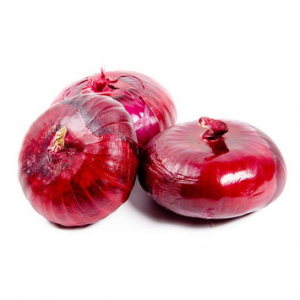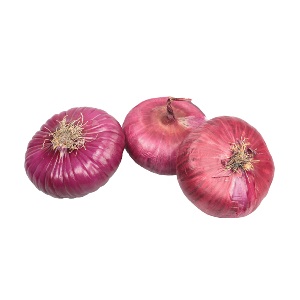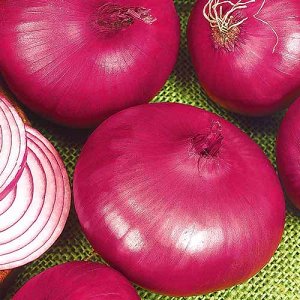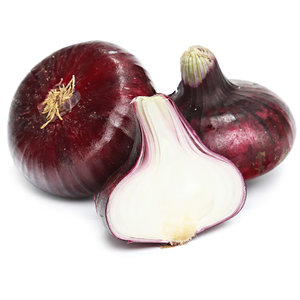One of the most delicious onion varieties: Yalta
The taste of Yalta onions is delicate, refined, absolutely devoid of bitterness. The harvest with standard taste is obtained in Crimea, but special agronomic techniques will help to grow pink onions in any part of Russia. To do this, you will have to work hard, and how exactly - read on.
The content of the article
Description of the Yalta onion variety
Yalta onion has characteristic features that make it easy to distinguish it from any other variety.
Origin and development

Breeding work on the breeding of Yalta onions took place in the middle of the last century in the Crimea, in the Nikitsky Botanical Garden. The material for breeding was the Mader flat and local dark sweet varieties imported from Portugal in the 19th century.
Chemical composition, trace elements and vitamins, useful properties
Yalta onions are classified as sweet salad varieties with a minimum amount of essential oils that irritate the mucous membranes of the body. Chemical composition Crimean onion is unique. It contains in very large quantities:
- flavonoids and vitamin C - to prevent capillary fragility and purify the blood;
- allicin - an antiseptic component to fight colds;
- antioxidants - to normalize the processes of rejuvenation in the cells of the body.
Regular consumption of salad onions:
- lowers cholesterol levels;
- thins thick blood;
- removes excess fluid;
- increases libido.
On a note! In ancient Russia, newlyweds were given raw onions for breakfast after their wedding night as a natural aphrodisiac.
After eating Yalta onions, there is no bad breath; during cutting, it does not cause strong tearing.
Application features
Yalta onions are nourishing and sweet, they are eaten in large quantities raw. The vegetable is especially good as a cut for grilled meat. During heat treatment, all the beneficial properties of salad onions are lost, vitamin C and antioxidants are completely destroyed, so it cannot be fried, stewed, boiled.
On a note! A few drops of lemon juice, apple cider vinegar or wine vinegar will perfectly accentuate the taste of finely chopped salad onions and reveal its aroma.
Ripening period
The growing season of the Yalta onion is 140-150 days. Ripening period - late August - early September.
Attention! Even in the mild climate of the Crimean peninsula, it is impossible to buy a real Yalta onion of the current year before the end of summer. disembarkation.
Yield

The Yalta variety is very picky about the quality of the soil, the length of daylight hours and the temperature regime. Insufficient lighting leads to the accumulation of bitterness in the bulbs.
In a temperate continental climate, it is recommended to plant lettuce onions in seedlings, in greenhouses with additional heating and lighting. The expected yield of Crimean onions when grown by seedlings is 100 kg / c.
Disease resistance
Bulbous plants get sick in conditions of excessive moisture and lack of sunlight. Yalta onion grows well and is not subject to contamination while growing in Crimea, between Yalta and Alushta, in a mountainous area with unique climatic conditions. In other geographic areas, the Crimean onion often suffers from insect attacks and is affected by fungal diseases.
Characteristics of the bulb, description of the appearance, taste
Yalta onions have similar characteristics to other salad varieties. Unscrupulous sellers often pass off the Veselka variety or the Bruskovik F1 hybrid for the Yalta onion.

The original Yalta onion bulbs have a number of characteristic features:
- red or beetroot color of dry scales;
- flat rounded shape of bulbs with a convex root;
- the number of layers per cut - no more than seven;
- layer thickness on the inner cut - 5-6 mm;
- lack of intense onion smell;
- clear juice and sweet taste without bitterness.
The shelf life of real Yalta onions never exceeds 4-5 months, so it is impossible to buy it in winter and spring.
Growing regions and climate requirements
Only a tiny territory in the Crimea in the Nikitsky Botanical Garden provides ideal conditions for the growth of the Yalta onion. The vegetable grown in other regions of Crimea will taste bitter. The most suitable climate in which it is grown with minimal effort is the Crimean Peninsula and Krasnodar Territory. In areas with a temperate climate, the cultivation of Crimean onions will require additional efforts and equipment of a capital greenhouse.
Advantages and disadvantages
Sweet, tasty Yalta onions can be eaten raw in unlimited quantities. Among the main advantages of the variety, there are no contraindications for use by people with gastrointestinal problems. The disadvantages include:
- limited area of natural cultivation;
- high labor costs when cultivating in cold regions;
- limited time storage;
- the likelihood that others are being issued for this variety on sale.
Difference from other varieties
For ripening, Yalta onions need at least four months from the date of planting. He is very picky about the length of daylight hours and the presence of direct sunlight. Unlike other varieties, Yaltinsky categorically does not tolerate excessive watering and rots in the ground.
Features of planting and growing
Like any onion, the Crimean variety is a biennial. In the first year, seed sets are grown, in the second, a full harvest is obtained.
Preparing for landing
As a prophylaxis of diseases, before planting, the seeds are soaked in a solution "Baikal EM-1" or sprayed with a slightly pink solution of potassium permanganate.
Ground requirements
Tauride schists, which cover the main part of the territory of the mountainous Crimea, are the best grounds for breeding the Yalta onion. During the day, under sunlight, they actively accumulate heat, and at night they gradually give it to plants. This is the secret of obtaining a delicate sweet taste.
The creation of a greenhouse effect when growing onions helps to bring conditions as close to natural ones as possible. To do this, a 20 cm thick layer of earth is removed from the garden bed and fresh manure is laid in a layer of 5-7 cm. The organic layer is covered with removed soil and sevok is planted. During natural decay, manure generates heat sufficient for the active growth of Yalta onions in a temperate climate.
On a note... Lean or depleted soils are additionally fertilized with ammonium nitrate or potassium salt before planting salad onions in early spring, according to the instructions.
Predecessors
The best predecessors for Yalta onions are tomatoes, cabbage, radishes, and leafy vegetables. It is not recommended to plant other varieties of crops near Yalta onions.
Timing, scheme and landing rules
When grown in the southern regions of the Russian Federation, the optimal timing for planting seeds in equipped greenhouses or hotbeds is February - early March. In the central and northern regions seed sow in boxes and grow sevok in an apartment. Seeds are planted in prepared containers to a depth of 1 cm with a distance of 5 cm between rows.
The optimal time for planting one-year-old seedlings in the ground is April - early May. When planting, the sevok is deepened by 5-6 cm, leaving a distance between the bulbs of 10 cm, between the rows - 30-40 cm. Before planting, the seed is hardened. To do this, the bulbs are taken out into the open air and left for 4-5 hours at a temperature of 5-7 ° C. Events are held during the week.
The nuances of care
To prevent the seedlings from pulling out, the containers are placed in a warm, well-lit place and covered with foil... When the first shoots appear, the film is removed and the seedlings are sprayed daily from a spray bottle. If necessary, the seedlings are illuminated with fluorescent lamps to increase daylight hours up to 10 hours. The optimal temperature regime is 20-24 ° С during the day and 18-19 ° С at night.
Yalta onion requires constant attention and conditions that are as close to natural as possible.
Watering mode
The main difficulty in growing Yalta onions is maintaining the correct watering regime. Excessive moisture or drying out of the soil is unacceptable. Watering is carried out every 2-3 days. 10-15 days before harvesting, soil moisture is stopped.
Loosening the soil and weeding
For the development of full-fledged bulbs, the soil is regularly loosened, providing oxygen access. Weeds are removed periodically.
Top dressing
Yalta onion responds well to fertilization in the soil. Two weeks after the emergence of seedlings, mineral fertilizers are applied to the soil:
- 10 g superphosphate;
- 5 g of urea;
- 3 g of potassium chloride;
- 5 liters of water.
When growing seedlings in open ground, on the 20th day after planting, the sprouts are fed with chicken dung at the rate of 1 liter of organic matter per 20 liters of water. Watering is carried out in the early morning or late evening after sunset.
Disease and pest control

With strict adherence to the rules of care, the plant has good immunity and independently copes with all kinds of diseases.
Excessive watering leads to damage by powdery mildew, gray mold, fusarium wilting. To combat diseases, the beds are sprayed with the drug "Fitosporin" or "Phytocide".
In the event of the appearance of insects, the affected plants are removed, and healthy ones are treated:
- when attacked by an onion tick - "Aktara";
- leaf miner - "Pyrethrum";
- onion flies - saline solution at the rate of 200 g per 10 liters of water.
Growing difficulties
The main difficulty in growing a sweet "Crimean" is to ensure optimal lighting and watering. To increase daylight hours, fluorescent lamps are used. Watering regularly - every 2-3 days - through a spray.
Harvesting and storage
The optimal time for harvesting from open ground is late July - early August.
How and when to collect
A sign of maturation is wilting and yellowing the green part of the plant. If the tip has dried up by 15-20% of the length, watering is stopped for 12-15 days, then the onion is removed from the ground.
If it rains, the bulbs are shaken off the lumps of soil and dried in a dry room. To do this, the crop is laid out in one layer on a burlap. After 3-4 days, they are sorted and put into boxes. Only whole, undamaged bulbs are suitable for long-term storage.
Storage features and keeping quality of the variety
How to store Crimean onions? It has a very poor keeping quality. The maximum period for which it is possible to preserve the harvest is until the beginning of December. Further, the vegetable loses its valuable properties, is bitter and rots from the root.
Store onions in a dry dark place at a temperature of 5-7 ° C.Once a month, the crop is sorted out and rotten, damaged bulbs are removed.
How to store in an apartment
In the apartment, the Yalta onion is stored in dried wooden boxes in the closet or on the insulated loggia. Direct sunlight is not allowed.
On a note. Crimeans keep the Yalta onion, weaving it into braids, 30-40 pieces per bundle.
Tips from experienced gardeners
Experienced gardeners are happy to share their own experience, which helps to harvest a good harvest of Yalta onion in harsh climatic conditions:
- when insect pests appear, the row spacing is covered with ash after treating the beds with insecticides;
- when equipping a greenhouse, fresh manure is replaced with a layer of quartz, which is covered with clay and fertile soil;
- during storage of the crop, they provide air humidity of no more than 50-55%.
How to get seeds
To get the seeds of the Yalta onion, 1-2 onions are left for cultivation in the garden. Plants with straight arrows with a waxy bloom up to 120 cm long are considered the best. At the end of such an arrow, a flower with black seeds is formed, which are harvested until they fall into the ground. The seeds are shaken out and dried well. Store in a dry place in a linen bag until spring.
Reviews of the Yalta onion variety
Beginners and experienced agronomists have different experiences in the cultivation of Yalta onions.
Alexander, Vyborg: “I have been growing onions in seedlings for the third year in a row. He is very picky about warmth and light, constantly needs attention, does not forgive mistakes and negligence. But the result is worth it. The Crimean red onion tastes sweet, the pungency is minimal. "
Vladimir, Moscow region: "Last year I could not grow, the plantings froze during the May frosts. This year I drew conclusions and protected the seedlings with sacking. The result was pleasing at the end of June. The bulbs are juicy and sweet, no worse than the Crimean ones.
Marina, Oryol: “I first saw the red Crimean onion in the photo, then I bought seeds in Crimea. I went up well, amicably. The summer was rainy, so it ripened to large bulbs of the same shape. A little bit bitter though. I think the Yalta sun is not enough ”.
Conclusion
Yalta onion is a whimsical plant that requires serious effort during cultivation. However, with strict adherence to agricultural technology in protected ground conditions, it is possible to grow good quality salad onions in any region of Russia.